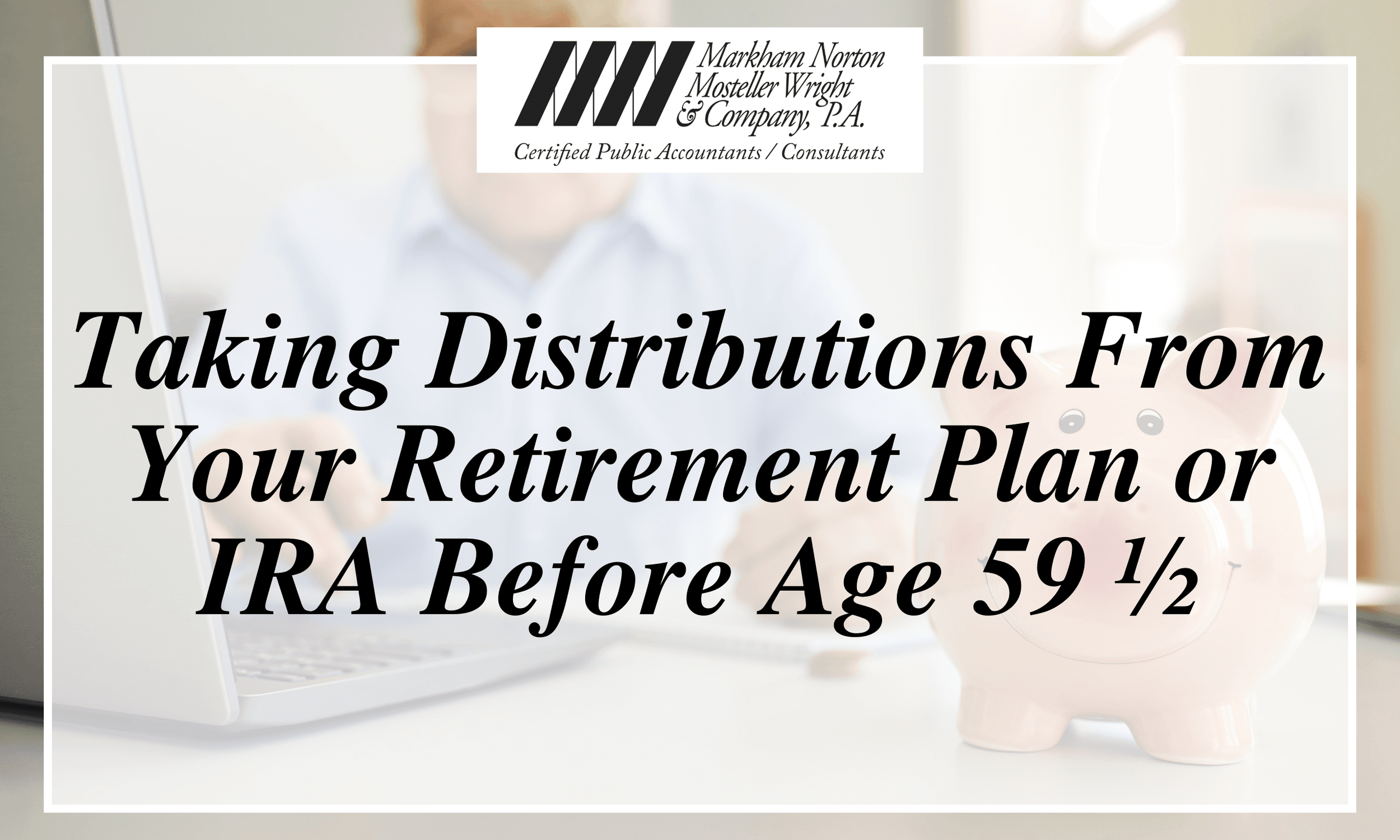Taking Distributions From Your Retirement Plan or IRA Before Age 59 ½
Saving for retirement occurs over a period of perhaps 40 or more years. And over those 40-odd years, you may run into life-situations and need to withdraw from your retirement savings early. If you do, withdrawals are normally subject to ordinary income tax, and if taken prior to reaching age 59 ½ may be subject to an additional 10% tax. Here are a few things to consider before withdrawing from your retirement plan or IRA.
Additional 10% tax on early distributions
If you take distributions from retirement plans and IRAs before the age of 59 ½, you may owe an additional 10% tax on the taxable amount of the early distributions, unless you meet an exception. There are more than 20 exceptions, including several new exceptions added by the SECURE Act and SECURE 2.0 Act.
IRAs and IRA-based plans
Individuals can take distributions from their IRA, SEP-IRA or SIMPLE-IRA at any time. Taxpayers don’t need to show a hardship to take a distribution – they can just request a withdrawal from the financial institution that holds the account.
Distributions from a traditional IRA are subject to ordinary income tax. Withdrawals before age 59 ½ may be subject to the 10% early distribution tax unless an exception applies. Qualified distributions from a Roth IRA are not subject to income tax (generally, after you’ve had the Roth account for five years and reach 59 ½).
Workplace retirement plans: 401(k), 403(b) and 457(b)
Taxpayers can take distributions from these plans only when certain life events occur, for example retiring or becoming disabled. The plan’s summary description should clearly state when you can take a distribution from the plan while still working for that employer. Many plans allow participants to take a distribution on account of a hardship, or take a loan from the plan for any reason.
Hardship distributions
You may be able to take a distribution from a governmental 457(b) plan because of an unforeseen emergency, or from a 401(k) or 403(b) plan because of an immediate and heavy financial need. Distributions due to a hardship can only cover the amount of your emergency, or that of your spouse or dependent, and is subject to withholding.
You should report hardship distributions as gross income when you file your tax return unless the distributions are designated Roth contributions. Hardship distributions can’t be repaid to the plan or rolled over to another plan.
Any distribution before you reach age 59 ½ may result in a 10% additional tax on the amount withdrawn unless an exception applies. Distributions from a 457(b) plan are not subject to the 10% early distribution tax.
Loans
Some plans may allow you to take loans if you meet certain plan limits on loan amounts and other requirements. You might be able to borrow up to the lesser of $50,000 or 50% of your account balance and must repay the loan over no more than 5 years. If the loan meets the plan rules and is repaid on time, these loans are not subject to tax.
Reporting distributions from retirement plans
People of all ages need to report distributions, including unpaid loans from retirement plans, as gross income on their tax return. Qualified distributions from Roth IRAs and designated Roth accounts are excluded from gross income.
To report distributions to the IRS:
- Include distributions on your Form 1040, Individual Income Tax Return
- Report early distributions on Form 5329, Additional Taxes on Qualified Plans, Including IRAs, and Other Tax-Favored Accounts
- Determine if an early distribution meets one of the exceptions to the additional 10% tax on early distributions.
- Report qualified disaster distributions and repayments on Form 8915-F
Exceptions to the additional 10% tax on early distributions
Distributions after age 59 ½, on account of death or disability, and certain distributions to qualified military reservists called to active duty are common exceptions to the 10% additional tax on early distributions from retirement plans and IRAs.
Some exceptions only apply to early distributions from IRAs. These include distributions for first-time homebuyers and for qualified higher education expenses.
Other exceptions only apply to early distributions from retirement plans. These include distributions after separation from service after reaching age 55, and distributions under a Qualified Domestic Relations Order.
Source: IRS Employee Plans News
___________________________________________
Our firm provides the information on our blog/vlog for general guidance only, and does not constitute the provision of legal advice, tax advice, accounting services, investment advice, or professional consulting of any kind. The information provided herein should not be used as a substitute for consultation with professional tax, accounting, legal, or other competent advisors. Before making any decision or taking any action, you should consult a professional advisor who has been provided with all pertinent facts relevant to your particular situation. Tax articles on this website are not intended to be used, and cannot be used by any taxpayer, for the purpose of avoiding accuracy-related penalties that may be imposed on the taxpayer. The information is provided “as is,” with no assurance or guarantee of completeness, accuracy, or timeliness of the information, and without warranty of any kind, express or implied, including but not limited to warranties of performance, merchantability, and fitness for a particular purpose.


